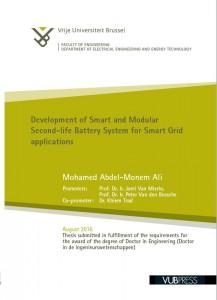
In the upcoming years, thousands of battery storage systems will be decommissioned from electric vehicles (i.e., PHEV, HEV and BEV). Instead of recycling or sending them immediately to landfills, these battery systems could be reused in other applications, such as grid or end- user applications. From an environmental perspective, final recycling of the second-life batteries requires costs and potential waste. Thus, their economic and environmental value could be maximized prior to recycling by refurbishing the used battery and repurposing them in stationary applications.
While the need and the opportunities for second-life batteries are obvious, a number of gaps and limitations currently constrain the adoption of using the second-life batteries. Consequently, extensive research work has been conducted to provide solutions for these challenges. In this PhD dissertation, a comprehensive technical analysis has been provided by addressing all aspects of a battery’s life cycle in order to investigate the feasibility of reusing retired EV batteries in the stationary applications. This dissertation presents a comprehensive analysis of the performance of second-life batteries (EIG 7 Ah battery cells and LiFePO4 18650 battery blocks). The benefits and the drawbacks of the existing characterization tests are provided.
In order to increase the lifetime of the lithium-ion battery, static and dynamic charging profiles for LiFePO4-based cells (LFP) were investigated to select the proper charging profile. The results revealed that the dynamic fast charging profile has a significant impact on reducing the capacity fade of the lithium-ion battery cells compared to the static fast charging profile.
Then, the Generic Ageing Model has been developed for on-line and/or off-line SoH estimation. Based on the proposed model, a new assessment methodology has been developed for testing and sorting the second-life batteries based upon the resonance impedance of these battery cells.
In the framework of this dissertation, a novel smart modular management system (SMMS) has been proposed for rechargeable energy storage systems, which have energy storage cells connected together in an array of cells. The innovative system consists of a control unit for deciding the operating mode, such as balancing or testing or protecting modes. The SMMS also provides a smart configuration with a single resistor to perform different operating modes (i.e., balancing, protecting and testing modes) in order to eliminate the imbalance between the cells and estimate the SoH and/or the SoC of batteries. It has also the ability to accomplish all modes with significant savings in energy loss with high efficiency in order to decrease the operating cost of the management system.
Finally, this dissertation proposes an innovative energy management strategy (GEMS), which could be used for managing the energy flow and for distributing the load demand among the second-life battery modules based on their performance.
The comprehensive technical analysis, including lifetime analysis, estimation techniques, new BMS configuration and control strategies, which has been proposed in this dissertation, can be considered as a step forward in deploying widespread commercialization of the second- life battery modules/packs.
Promotors: Prof. dr. ir. Joeri Van Mierlo (VUB) and prof. dr. ir. Peter Van den Bossche (VUB)
Co-promotor: Prof. dr. Khiem Trad (VITO)
Committee members: Prof. dr. ir. Annick Hubin (VUB) – Prof. dr. ir. Rik Pintelon (VUB) – prof. dr. Noshin Omar (VUB) – prof. dr. ir. Daniel Hissel (University of Franche-Comte) – prof. dr. ir. Alex Van den Bossche (UGent) – prof. dr. ir. Philippe Lataire (VUB) – dr. Omar Hegazy (VUB)
